H-BIM and Artificial Intelligence: Classification of Architectural Heritage for Semi-Automatic Scan-to-BIM Reconstruction
Abstract
1. Introduction
2. Related Work
2.1. State-of-the-Art Scan-to-BIM Reconstruction Processes
2.1.1. Manual Scan-to-BIM Methods
2.1.2. Semi-Automated Scan-to-BIM Methods
2.2. State-of-the-Art AI-Based Semantic Segmentation
2.3. Open Issues Arising from the State-of-the-Art Methods
- A breakdown of the survey data into subsets of elements (pixels or points) sharing the same features, whether geometric or radiometric, extracted from 2D or 3D descriptors and according to predefined criteria (segmentation);
- The assignment of a label to each subset (classification or semantic segmentation).
3. Materials and Methods
3.1. Materials
- The Grand (or main) cloister of the Pisa Charterhouse. The cloister, extending an area of about 70 × 45 m, was built starting from the year 1375 and underwent major renovations in the 17th century. The perimeter walkway, covered by vaulted ceilings and enclosed by marble columns, once provided access to the cells of the Carthusian fathers. The point cloud is the result of a Leica ScanStation C10 laser scanner survey (~10 M points).
- The Grand-Ducal cloister of the Pisa Charterhouse. Extending a rectangular-shaped area of 12 × 14 m, this cloister dates back to the 14th century. Its structure underwent several transformations around the 17th century, that lent it its current layout. The courtyard, with a central cistern, is overlooked by vaulted galleries; the two opposite sides of the cloister are connected, on the first floor, by an overhead walkway. The considered point cloud is the outcome of an integration between laser scanning and drone-based photogrammetric surveys (~6 M points).
- The cloister of the convent of San Matteo in Pisa. This cloister is located in the medieval convent of San Matteo in Pisa, which currently houses a National Museum. Major changes of its layout, dated to the 16th century, involved the construction of a portico, with granite columns closing the central space, Gothic windows and a cross-vaulted ambulatory. The survey was carried out via terrestrial photogrammetry and the resulting point cloud consists of ~12 M points.
3.2. Methods
3.2.1. Semantic Segmentation via ML
- (i)
- Neighborhood selection and feature extraction;
- (ii)
- Feature selection;
- (iii)
- Manual annotation on a reduced portion of the dataset (training set) to identify classes of elements;
- (iv)
- Application of the RF classifier and consequent accuracy evaluation;
- (v)
- Generation of an annotated 3D point cloud.
3.2.2. Scan-to-BIM Reconstruction
- (i)
- Import of the annotated point cloud into 3D modeling environment, and extraction of the single class concerned by the reconstruction process;
- (ii)
- Reconstruction of a template geometry for each class of architectural elements identified, while referring to architectural treatises and based on the definition of base construction plans, constraints, generating primitives, base profiles and ensuing functions of extrusion, loft, sweep, etc.;
- (iii)
- Propagation of the template geometry to all elements belonging to a typological class, i.e., definition of element replica operations, so to enable the duplication of the defined geometry to multiple elements sharing same characteristics.
4. Results
4.1. Annotated 3D Data
4.2. Semantic-Based Reconstruction on Annotated Data
4.2.1. Import of Annotated Data
4.2.2. Libraries of Template Geometries
- Definition of template conceptual shapes of each class of architectural elements identified on the point cloud, through a series of processing operations, rules (nodes) attributes and connections (wires).
- Control of the different graphic elements that compose the reconstructed shapes and direct manipulation of sliders related to their dimensions, extension and other and properties.
- Reference building planes were detected and suitably oriented;
- A generating profile was created via VPL and, where necessary, a direction path was outlined.
- Functions such as revolution, sweep, extrusion, loft, etc. of the identified profile were used to build the targeted surface.
4.2.3. Information Propagation and Import into BIM Software
5. Discussion
5.1. Assessment of ML-Based Classification Methods
- After observing the confusion matrices (Appendix A, Figure A4) and visually checking the data with the segmentation results, we observed misclassifications in the boundary regions, that is, in those areas that mark the boundary between one class and another. Specifically, as features are computed in a given local neighborhood ρ, feature extraction can be misleading for those 3D points that are in the boundary regions between classes (Figure 25). Those errors increase with increasing radius of the spherical neighborhood. This situation was mitigated, on the one hand, by adding discriminative radiometric features based on color information and, on the other hand, by choosing low (<0.6 m) values of ρ.
- Regions with similar developments (e.g., planar or cylindrical) in which geometric features may yield several values, can be misclassified as falling into the same class. For instance, the analysis of the off-diagonal elements of the confusion matrices suggested that Class 5—Wall’ and ’Class 4—Door and Window’ are often interchanged with each other, as both are characterized by predominantly planar behaviors.
- As the covariance and curvature features are computed in a given local neighborhood, the density of the point cloud influences the classification results. In other words, if two point clouds of a same object have different point densities, feature selection may produce two different results, as seen in the example in Figure 26. In order to align feature selection for different surveys of the same dataset, one could then plan to return the point clouds to the same density by means of a subsampling operation.
5.2. Assessment of the Scan-to-BIM Reconstruction Workflow
6. Conclusions
Author Contributions
Funding
Data Availability Statement
Conflicts of Interest
Abbreviations
| AI | Artificial Intelligence |
| BIM | Building Information Modeling |
| DL | Deep Learning |
| FN | False Negatives |
| FP | False Positives |
| H-BIM | Heritage- or Historic- Building Information Modeling |
| ML | Machine Learning |
| RF | Random Forest |
| TN | True Negatives |
| TP | True Positives |
| VPL | Visual Programming Language |
Appendix A

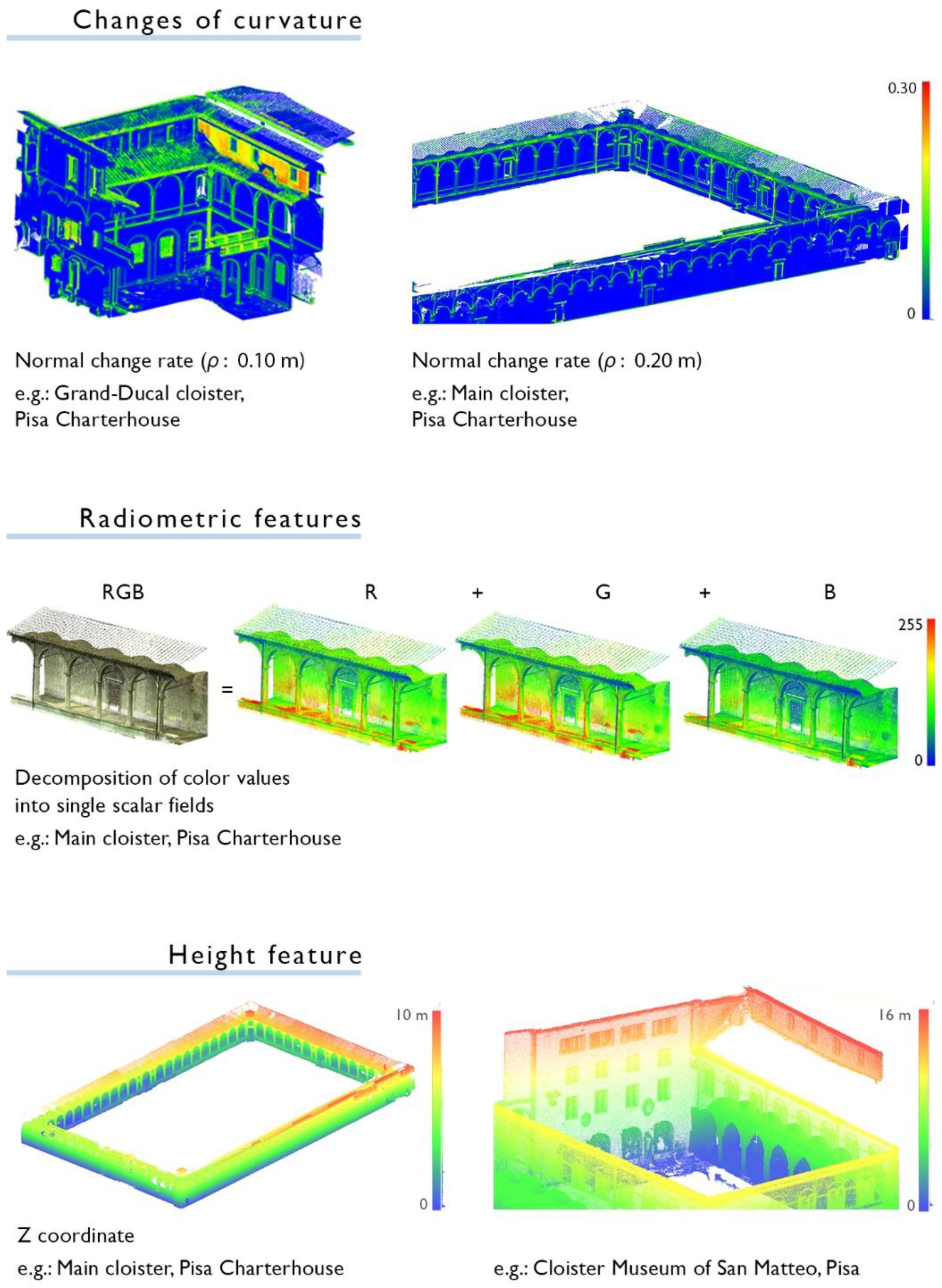

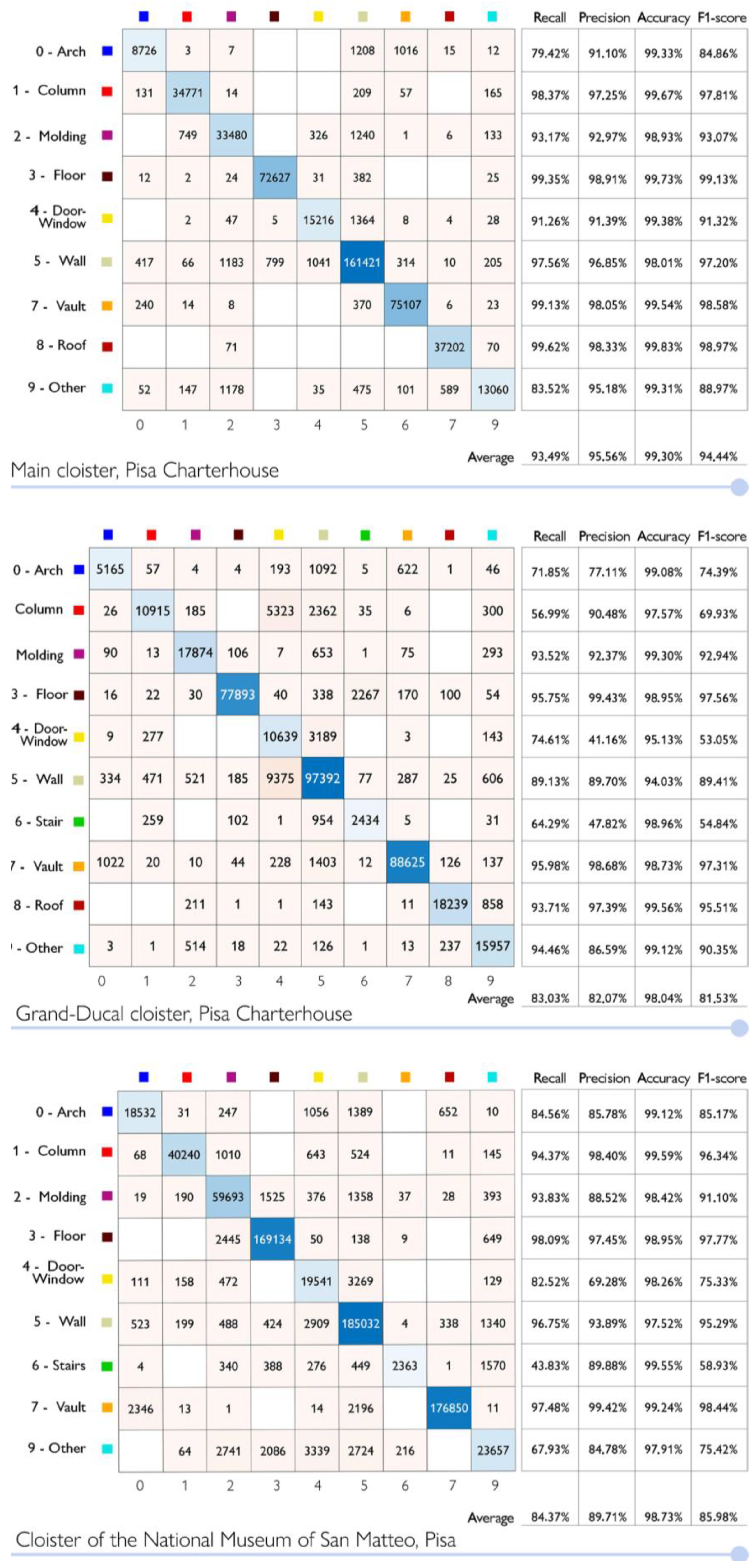
References
- Dore, C.; Murphy, M. Semi-automatic techniques for as-built BIM façade modeling of historic buildings. In Proceedings of the 2013 Digital Heritage International Congress (DigitalHeritage), IEEE, Marseille, France, 28 October 2013–1 November 2013; pp. 473–480. [Google Scholar]
- Murphy, M.; McGovern, E.; Pavia, S. Historic building information modelling (HBIM). Struct. Surv. 2009, 27, 311–327. [Google Scholar] [CrossRef]
- López, F.; Lerones, P.; Llamas, J.; Gómez-García-Bermejo, J.; Zalama, E. A Review of Heritage Building Information Modeling (H-BIM). MTI 2018, 2, 21. [Google Scholar] [CrossRef]
- Pocobelli, D.P.; Boehm, J.; Bryan, P.; Still, J.; Grau-Bové, J. BIM for heritage science: A review. Herit. Sci. 2018, 6, 30. [Google Scholar] [CrossRef]
- Pătrăucean, V.; Armeni, I.; Nahangi, M.; Yeung, J.; Brilakis, I.; Haas, C. State of research in automatic as-built modelling. Adv. Eng. Inform. 2015, 29, 162–171. [Google Scholar] [CrossRef]
- Logothetis, S.; Delinasiou, A.; Stylianidis, E. Building Information Modelling for Cultural Heritage: A review. ISPRS Ann. Photogramm. Remote Sens. Spat. Inf. Sci. 2015, II-5/W3, 177–183. [Google Scholar] [CrossRef]
- Volk, R.; Stengel, J.; Schultmann, F. Building Information Modeling (BIM) for existing buildings—Literature review and future needs. Autom. Constr. 2014, 38, 109–127. [Google Scholar] [CrossRef]
- Hichri, N.; Stefani, C.; De Luca, L.; Veron, P.; Hamon, G. From point cloud to BIM: A survey of existing approaches. Int. Arch. Photogramm. Remote Sens. Spat. Inf. Sci. 2013, XL-5/W2, 343–348. [Google Scholar] [CrossRef]
- Miceli, A.; Morandotti, M.; Parrinello, S. 3D survey and semantic analysis for the documentation of built heritage. The case study of Palazzo Centrale of Pavia University. VITRUVIO Int. J. Archit. Technol. Sustain. 2020, 5, 65. [Google Scholar] [CrossRef]
- Oreni, D.; Brumana, R.; Georgopoulos, A.; Cuca, B. HBIM for conservation and built heritage: Towards a library of vaults and wooden bean floors. ISPRS Ann. Photogramm. Remote Sens. Spat. Inf. Sci. 2013, II-5/W1, 215–221. [Google Scholar] [CrossRef]
- Arayici, Y. Towards building information modelling for existing structures. Struct. Surv. 2008, 26, 210–222. [Google Scholar] [CrossRef]
- Fai, S.; Sydor, M. Building Information Modelling and the documentation of architectural heritage: Between the ‘typical’ and the ‘specific’. In Proceedings of the 2013 Digital Heritage International Congress (DigitalHeritage), Marseille, France, 28 October 2013–1 November 2013; Volume 1, pp. 731–734. [Google Scholar]
- Bacci, G.; Bertolini, F.; Bevilacqua, M.G.; Caroti, G.; Martínez-Espejo Zaragoza, I.; Martino, M.; Piemonte, A. HBIM methodologies for the architectural restoration. The case of the ex-church of San Quirico all’Olivo in Lucca, Tuscany. Int. Arch. Photogramm. Remote Sens. Spat. Inf. Sci. 2019, XLII-2/W11, 121–126. [Google Scholar] [CrossRef]
- Angulo-Fornos, R.; Castellano-Román, M. HBIM as Support of Preventive Conservation Actions in Heritage Architecture. Experience of the Renaissance Quadrant Façade of the Cathedral of Seville. Appl. Sci. 2020, 10, 2428. [Google Scholar] [CrossRef]
- Barazzetti, L.; Banfi, F.; Brumana, R.; Gusmeroli, G.; Previtali, M.; Schiantarelli, G. Cloud-to-BIM-to-FEM: Structural simulation with accurate historic BIM from laser scans. Simul. Model. Pract. Theory 2015, 57, 71–87. [Google Scholar] [CrossRef]
- Croce, P.; Landi, F.; Puccini, B.; Martino, M.; Maneo, A. Parametric HBIM procedure for the structural evaluation of Heritage masonry buildings. Buildings 2022, 12, 194. [Google Scholar] [CrossRef]
- Pepe, M.; Costantino, D.; Restuccia Garofalo, A. An efficient pipeline to obtain 3D model for HBIM and structural analysis purposes from 3D point clouds. Appl. Sci. 2020, 10, 1235. [Google Scholar] [CrossRef]
- Brumana, R.; Oreni, D.; Cuca, B.; Binda, L.; Condoleo, P.; Triggiani, M. Strategy for integrated surveying techniques finalized to interpretive models in a Byzantine Church, Mesopotam, Albania. Int. J. Archit. Herit. 2014, 8, 886–924. [Google Scholar] [CrossRef]
- Pocobelli, D.P.; Boehm, J.; Bryan, P.; Still, J.; Grau-Bové, J. Building Information Modeling for monitoring and simulation data in heritage buildings. Int. Arch. Photogramm. Remote Sens. Spat. Inf. Sci. 2018, 42, 909–916. [Google Scholar] [CrossRef]
- Martinez Espejo Zaragoza, I.; Caroti, G.; Piemonte, A. The use of image and laser scanner survey archives for cultural heritage 3D modelling and change analysis. ACTA IMEKO 2021, 10, 114. [Google Scholar] [CrossRef]
- Brumana, R.; Oreni, D.; Barazzetti, L.; Cuca, B.; Previtali, M.; Banfi, F. Survey and Scan to BIM Model for the Knowledge of Built Heritage and the Management of Conservation Activities. In Digital Transformation of the Design, Construction and Management Processes of the Built Environment; Daniotti, B., Gianinetto, M., Della Torre, S., Eds.; Springer International Publishing: Cham, Switzerland, 2020; pp. 391–400. ISBN 978-3-030-33570-0. [Google Scholar]
- Bruno, S.; Musicco, A.; Fatiguso, F.; Dell’Osso, G.R. The Role of 4D Historic Building Information Modelling and Management in the Analysis of Constructive Evolution and Decay Condition within the Refurbishment Process. Int. J. Archit. Herit. 2019, 15, 1250–1266. [Google Scholar] [CrossRef]
- Macher, H.; Landes, T.; Grussenmeyer, P. From Point Clouds to Building Information Models: 3D Semi-Automatic Reconstruction of Indoors of Existing Buildings. Appl. Sci. 2017, 7, 1030. [Google Scholar] [CrossRef]
- Bevilacqua, M.G.; Caroti, G.; Piemonte, A.; Terranova, A.A. Digital Technology and Mechatronic Systems for the Architectural 3D Metric Survey. In Mechatronics for Cultural Heritage and Civil Engineering; Intelligent Systems, Control and Automation: Science and Engineering; Ottaviano, E., Pelliccio, A., Gattulli, V., Eds.; Springer International Publishing: Cham, Switzerland, 2018; Volume 92, pp. 161–180. ISBN 978-3-319-68645-5. [Google Scholar]
- Fiorucci, M.; Khoroshiltseva, M.; Pontil, M.; Traviglia, A.; Del Bue, A.; James, S. Machine Learning for Cultural Heritage: A Survey. Pattern Recognit. Lett. 2020, 133, 102–108. [Google Scholar] [CrossRef]
- Matrone, F.; Grilli, E.; Martini, M.; Paolanti, M.; Pierdicca, R.; Remondino, F. Comparing Machine and Deep Learning Methods for Large 3D Heritage Semantic Segmentation. IJGI 2020, 9, 535. [Google Scholar] [CrossRef]
- Grilli, E.; Remondino, F. Classification of 3D Digital Heritage. Remote Sens. 2019, 11, 847. [Google Scholar] [CrossRef]
- Rocha, G.; Mateus, L.; Fernández, J.; Ferreira, V. A Scan-to-BIM Methodology Applied to Heritage Buildings. Heritage 2020, 3, 47–67. [Google Scholar] [CrossRef]
- Yang, X.; Koehl, M.; Grussenmeyer, P. Mesh-To-BIM: From segmented mesh elements to BIM model with limited parameters. Int. Arch. Photogramm. Remote Sens. Spat. Inf. Sci. 2018, 42, 1213–1218. [Google Scholar] [CrossRef]
- Bruno, S.; De Fino, M.; Fatiguso, F. Historic Building Information Modelling: Performance assessment for diagnosis-aided information modelling and management. Autom. Constr. 2018, 86, 256–276. [Google Scholar] [CrossRef]
- Previtali, M.; Barazzetti, L.; Brumana, R.; Scaioni, M. Towards automatic indoor reconstruction of cluttered building rooms from point clouds. ISPRS Ann. Photogramm. Remote Sens. Spat. Inf. Sci. 2014, 2, 281–288. [Google Scholar] [CrossRef]
- Bruno, N.; Roncella, R. HBIM for Conservation: A New Proposal for Information Modeling. Remote Sens. 2019, 11, 1751. [Google Scholar] [CrossRef]
- Tommasi, C.; Achille, C. Interoperability matter: Levels of data sharing, starting from a 3D information modeling. Int. Arch. Photogramm. Remote Sens. Spat. Inf. Sci. 2017, XLII-2/W3, 623–630. [Google Scholar] [CrossRef]
- Tang, P.; Huber, D.; Akinci, B.; Lipman, R.; Lytle, A. Automatic reconstruction of as-built building information models from laser-scanned point clouds: A review of related techniques. Autom. Constr. 2010, 19, 829–843. [Google Scholar] [CrossRef]
- Dore, C.; Murphy, M. Current state of the art Historic Building Information Modeling. Int. Arch. Photogramm. Remote Sens. Spat. Inf. Sci. 2017, 42, 185–192. [Google Scholar] [CrossRef]
- Xiong, X.; Adan, A.; Akinci, B.; Huber, D. Automatic creation of semantically rich 3D building models from laser scanner data. Autom. Constr. 2013, 31, 325–337. [Google Scholar] [CrossRef]
- Jung, J.; Hong, S.; Jeong, S.; Kim, S.; Cho, H.; Hong, S.; Heo, J. Productive modeling for development of as-built BIM of existing indoor structures. Autom. Constr. 2014, 42, 68–77. [Google Scholar] [CrossRef]
- Zhang, X. Curvature estimation of 3D point cloud surfaces through the fitting of normal section curvatures. Proc. Asiagraph 2008, 8, 23–26. [Google Scholar]
- Schnabel, R.; Wahl, R.; Klein, R. Efficient RANSAC for Point-Cloud Shape Detection. Comput. Graph. Forum 2007, 26, 214–226. [Google Scholar] [CrossRef]
- Fischler, M.A.; Bolles, R.C. Random sample consensus: A paradigm for model fitting with applications to image analysis and automated cartography. Commun. ACM 1981, 24, 381–395. [Google Scholar] [CrossRef]
- Hough, P.V.C. Method and Means for Recognizing Complex. Patterns. Patent 3,069,654, 18 December 1962. [Google Scholar]
- Thomson, C.; Boehm, J. Automatic Geometry Generation from Point Clouds for BIM. Remote Sens. 2015, 7, 11753–11775. [Google Scholar] [CrossRef]
- Bosché, F.; Ahmed, M.; Turkan, Y.; Haas, C.T.; Haas, R. The value of integrating Scan-to-BIM and Scan-vs-BIM techniques for construction monitoring using laser scanning and BIM: The case of cylindrical MEP components. Autom. Constr. 2015, 49, 201–213. [Google Scholar] [CrossRef]
- Wang, Z.; Shi, W.; Akoglu, K.; Kotoula, E.; Yang, Y.; Rushmeier, H. CHER-Ob: A Tool for Shared Analysis and Video Dissemination. J. Comput. Cult. Herit. 2018, 11, 1–22. [Google Scholar] [CrossRef]
- Hong, S.; Jung, J.; Kim, S.; Cho, H.; Lee, J.; Heo, J. Semi-automated approach to indoor mapping for 3D as-built building information modeling. Comput. Environ. Urban Syst. 2015, 51, 34–46. [Google Scholar] [CrossRef]
- Grassi, I. Applicazione della metodologia HBIM al Chiostro Granducale della Certosa di Calci: Restituzione semantica e mappatura tridimensionale del degrado. Master’s Thesis, Scuola di Ingegneria, Università di Pisa, Pisa, Italy, 2019. [Google Scholar]
- Santagati, C.; Lo Turco, M.; Garozzo, R. Reverse information modeling for historic artefacts: Towards the definition of a level of accuracy for ruined heritage. Int. Arch. Photogramm. Remote Sens. Spat. Inf. Sci. 2018, 42, 1007–1014. [Google Scholar] [CrossRef]
- Yang, X.; Lu, Y.-C.; Murtiyoso, A.; Koehl, M.; Grussenmeyer, P. HBIM Modeling from the Surface Mesh and Its Extended Capability of Knowledge Representation. IJGI 2019, 8, 301. [Google Scholar] [CrossRef]
- Rodríguez-Moreno, C.; Reinoso-Gordo, J.F.; Rivas-López, E.; Gómez-Blanco, A.; Ariza-López, F.J.; Ariza-López, I. From point cloud to BIM: An integrated workflow for documentation, research and modelling of architectural heritage. Surv. Rev. 2018, 50, 212–231. [Google Scholar] [CrossRef]
- Quattrini, R.; Battini, C.; Mammoli, R. HBIM TO VR. Semantic awareness and data enrichment interoperability for parametric libraries of historical architecture. Int. Arch. Photogramm. Remote Sens. Spat. Inf. Sci. 2018, 42, 937–943. [Google Scholar] [CrossRef]
- Baik, A. From point cloud to Jeddah Heritage BIM Nasif Historical House—Case study. Digit. Appl. Archaeol. Cult. Herit. 2017, 4, 1–18. [Google Scholar] [CrossRef]
- Fai, S.; Rafeiro, J. Establishing an appropriate Level of Detail (LoD) for a Building Information Model (BIM)—West Block, Parliament Hill, Ottawa, Canada. ISPRS Ann. Photogramm. Remote Sens. Spat. Inf. Sci. 2014, 2, 123–130. [Google Scholar] [CrossRef]
- De Luca, L.; Véron, P.; Florenzano, M. A generic formalism for the semantic modeling and representation of architectural elements. Vis. Comput. 2007, 23, 181–205. [Google Scholar] [CrossRef]
- Murphy, M.; McGovern, E.; Pavia, S. Historic Building Information Modelling—Adding intelligence to laser and image based surveys of European classical architecture. ISPRS J. Photogramm. Remote Sens. 2013, 14, 89–102. [Google Scholar] [CrossRef]
- Tommasi, C.; Achille, C.; Fassi, F. From point cloud to BIM: A modelling challenge in the Cultural Heritage field. Int. Arch. Photogramm. Remote Sens. Spat. Inf. Sci. 2016, 41, 429–436. [Google Scholar] [CrossRef]
- Andriasyan, M.; Moyano, J.; Nieto-Julián, J.E.; Antón, D. From Point Cloud Data to Building Information Modelling: An Automatic Parametric Workflow for Heritage. Remote Sens. 2020, 12, 1094. [Google Scholar] [CrossRef]
- Capone, M.; Lanzara, E. Scan-to-BIM vs. 3D ideal modela HBIM: Parametric tools to study domes geometry. Int. Arch. Photogramm. Remote Sens. Spat. Inf. Sci. 2019, 42, 219–226. [Google Scholar] [CrossRef]
- Kelly, G. A survey of procedural techniques for city generation. ITB J. 2006, 14, 342–351. [Google Scholar] [CrossRef]
- Pierdicca, R.; Paolanti, M.; Matrone, F.; Martini, M.; Morbidoni, C.; Malinverni, E.S.; Frontoni, E.; Lingua, A.M. Point Cloud Semantic Segmentation Using a Deep Learning Framework for Cultural Heritage. Remote Sens. 2020, 12, 1005. [Google Scholar] [CrossRef]
- Paumard, M.-M.; Picard, D.; Tabia, H. Deepzzle: Solving Visual Jigsaw Puzzles with Deep Learning and Shortest Path Optimization. IEEE Trans. Image Process. 2020, 29, 3569–3581. [Google Scholar] [CrossRef]
- Ibrahim, Y.; Nagy, B.; Benedek, C. Deep Learning-Based Masonry Wall Image Analysis. Remote Sens. 2020, 12, 3918. [Google Scholar] [CrossRef]
- Varinlioglu, G.; Balaban, O. Artificial Intelligence in Architectural Heritage Research: Simulating Networks of Caravanserais through Machine Learning; The Routledge Companion to Artificial Intelligence in Architecture; Basu, P., Ed.; Routledge: Abingdon-on-Thames, UK, 2021; ISBN 978-0-367-42458-9. [Google Scholar]
- Korc, F.; Forstner, W. eTRIMS Image Database for Interpreting Images of Man-Made Scenes. Comput. Sci. 2009, 12, 62918340. [Google Scholar]
- Manfredi, M.; Grana, C.; Cucchiara, R. Automatic Single-Image People Segmentation and Removal for Cultural Heritage Imaging. In New Trends in Image Analysis and Processing—ICIAP 2013; Petrosino, A., Maddalena, L., Pala, P., Eds.; Springer: Berlin/Heidelberg, Germany, 2013; pp. 188–197. [Google Scholar]
- Grilli, E.; Dininno, D.; Petrucci, G.; Remondino, F. From 2D to 3D supervised segmentation and classification for Cultural Heritage applications. Int. Arch. Photogramm. Remote Sens. Spat. Inf. Sci. 2018, 42, 399–406. [Google Scholar] [CrossRef]
- Musicco, A.; Galantucci, R.A.; Bruno, S.; Verdoscia, C.; Fatiguso, F. Automatic point cloud segmentation for the detection of alterations on historical buildings through an unsupervised and clustering-based Machine Learning approach. ISPRS Ann. Photogramm. Remote Sens. Spat. Inf. Sci. 2021, 2, 129–136. [Google Scholar] [CrossRef]
- Bassier, M.; Yousefzadeh, M.; Vergauwen, M. Comparison of 2D and 3D wall reconstruction algorithms from point cloud data for as-built BIM. ITcon 2020, 25, 173–192. [Google Scholar] [CrossRef]
- El Kadi, K.A. Automatic Extraction of Facade Details of Heritage Building Using Terrestrial Laser Scanning Data. J. Archit. Eng. Technol. 2014, 3, 2. [Google Scholar] [CrossRef]
- Morbidoni, C.; Pierdicca, R.; Paolanti, M.; Quattrini, R.; Mammoli, R. Learning from synthetic point cloud data for historical buildings semantic segmentation. J. Comput. Cult. Herit. 2020, 13, 1–16. [Google Scholar] [CrossRef]
- Grilli, E.; Farella, E.M.; Torresani, A.; Remondino, F. Geometric features analysis for the classification of Cultural Heritage point clouds. Int. Arch. Photogramm. Remote Sens. Spat. Inf. Sci. 2019, 42, 541–548. [Google Scholar] [CrossRef]
- Malinverni, E.S.; Mariano, F.; Di Stefano, F.; Petetta, L.; Onori, F. Modeling in HBIM to document materials decay by a thematic mapping to manage the Cultural Heritage: The case of Chiesa della Pietà in Fermo. Int. Arch. Photogramm. Remote Sens. Spat. Inf. Sci. 2019, 42, 777–784. [Google Scholar] [CrossRef]
- Weinmann, M. Reconstruction and Analysis of 3D Scenes; Springer International Publishing: Cham, Switzerland, 2016; ISBN 978-3-319-29244-1. [Google Scholar]
- Özdemir, E.; Remondino, F.; Golkar, A. Aerial point cloud classification with deep learning and machine learning algorithms. Int. Arch. Photogramm. Remote Sens. Spat. Inf. Sci. 2019, XLII-4/W18, 843–849. [Google Scholar] [CrossRef]
- Breiman, L. Ramdom forests. Mach. Learn. 2001, 45, 5–32. [Google Scholar] [CrossRef]
- Kyriakaki-Grammatikaki, S.; Stathopoulou, E.K.; Grilli, E.; Remondino, F.; Georgopoulos, A. Geometric primitive extraction from semantically enriched point clouds. Int. Arch. Photogramm. Remote Sens. Spat. Inf. Sci. 2022, 46, 291–298. [Google Scholar] [CrossRef]
- Croce, V.; Caroti, G.; De Luca, L.; Jacquot, K.; Piemonte, A.; Véron, P. From the Semantic Point Cloud to Heritage-Building Information Modeling: A Semiautomatic Approach Exploiting Machine Learning. Remote Sens. 2021, 13, 461. [Google Scholar] [CrossRef]
- Matrone, F.; Lingua, A.; Pierdicca, R.; Malinverni, E.S.; Paolanti, M.; Grilli, E.; Remondino, F.; Murtiyoso, A.; Landes, T. A benchmark for large-scale heritage point cloud semantic segmentation. Int. Arch. Photogramm. Remote Sens. Spat. Inf. Sci. 2020, 43, 1419–1426. [Google Scholar] [CrossRef]
- Scamozzi, V.; Vincenzo, W. L’idea Dell’architettura Universale; Colpo di Fulmine Edizioni: Venezia, Italy, 1615. [Google Scholar]
- Kowalczyk, K.; Rapinski, J. Investigating the error sources in reflectorless EDM. J. Surv. Eng. 2014, 140, 06014002. [Google Scholar] [CrossRef]
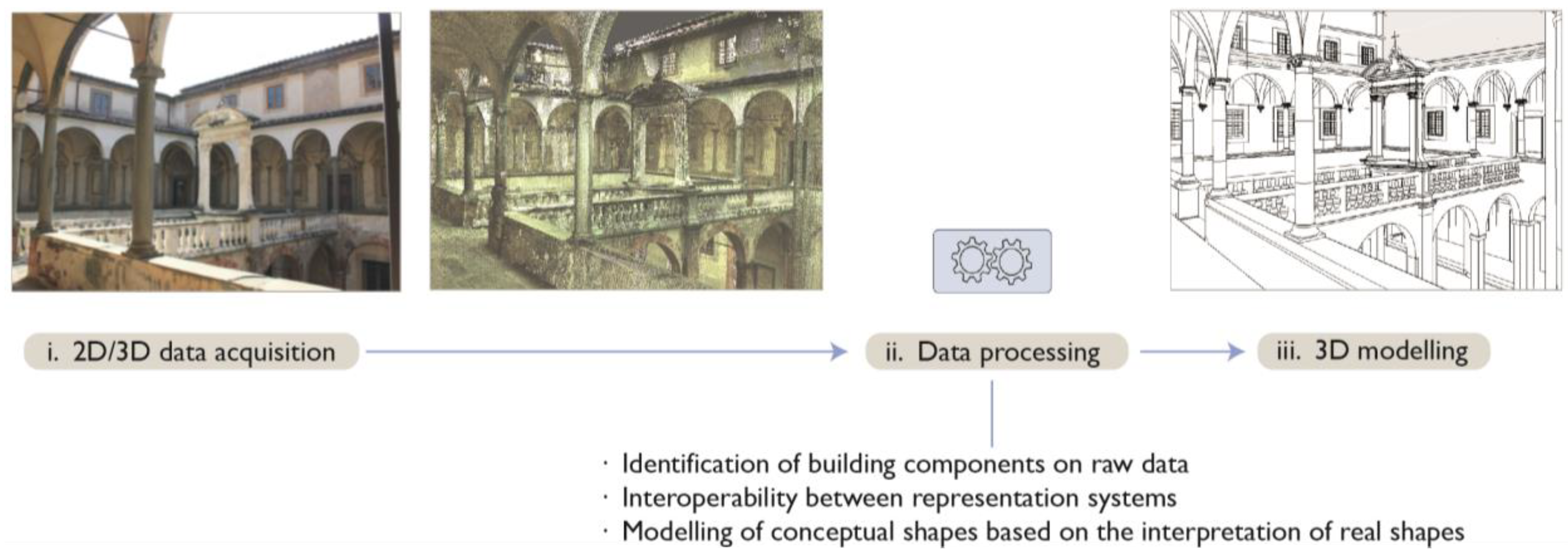
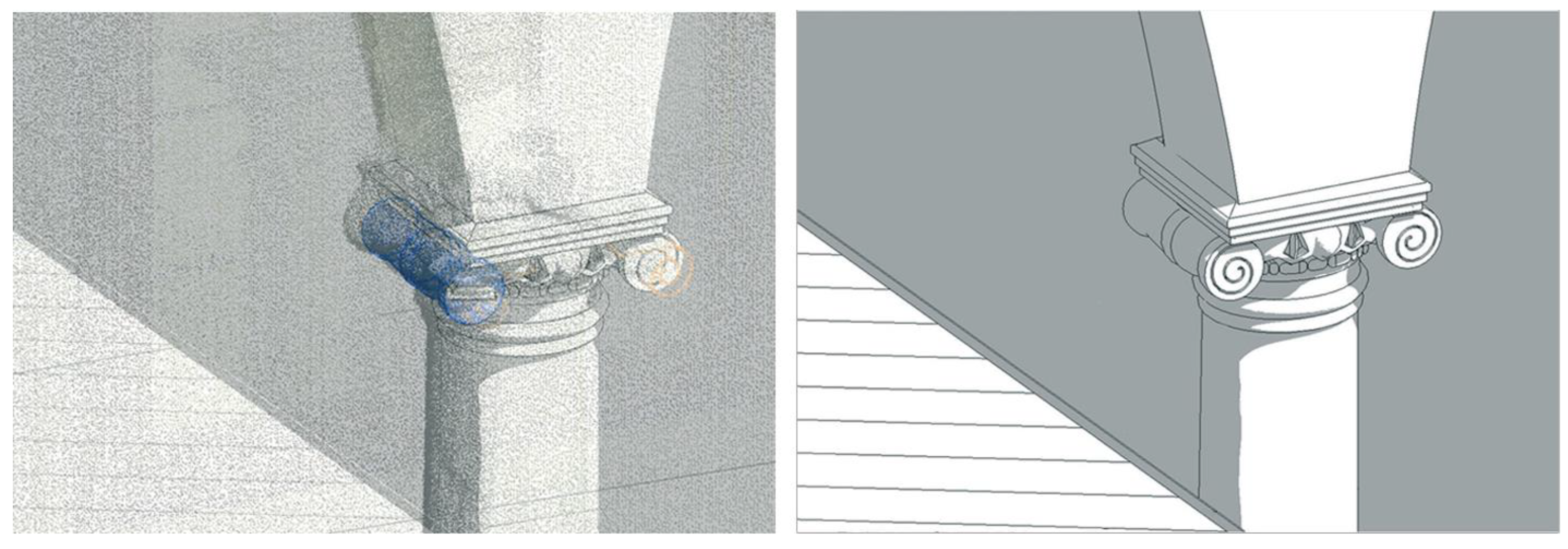

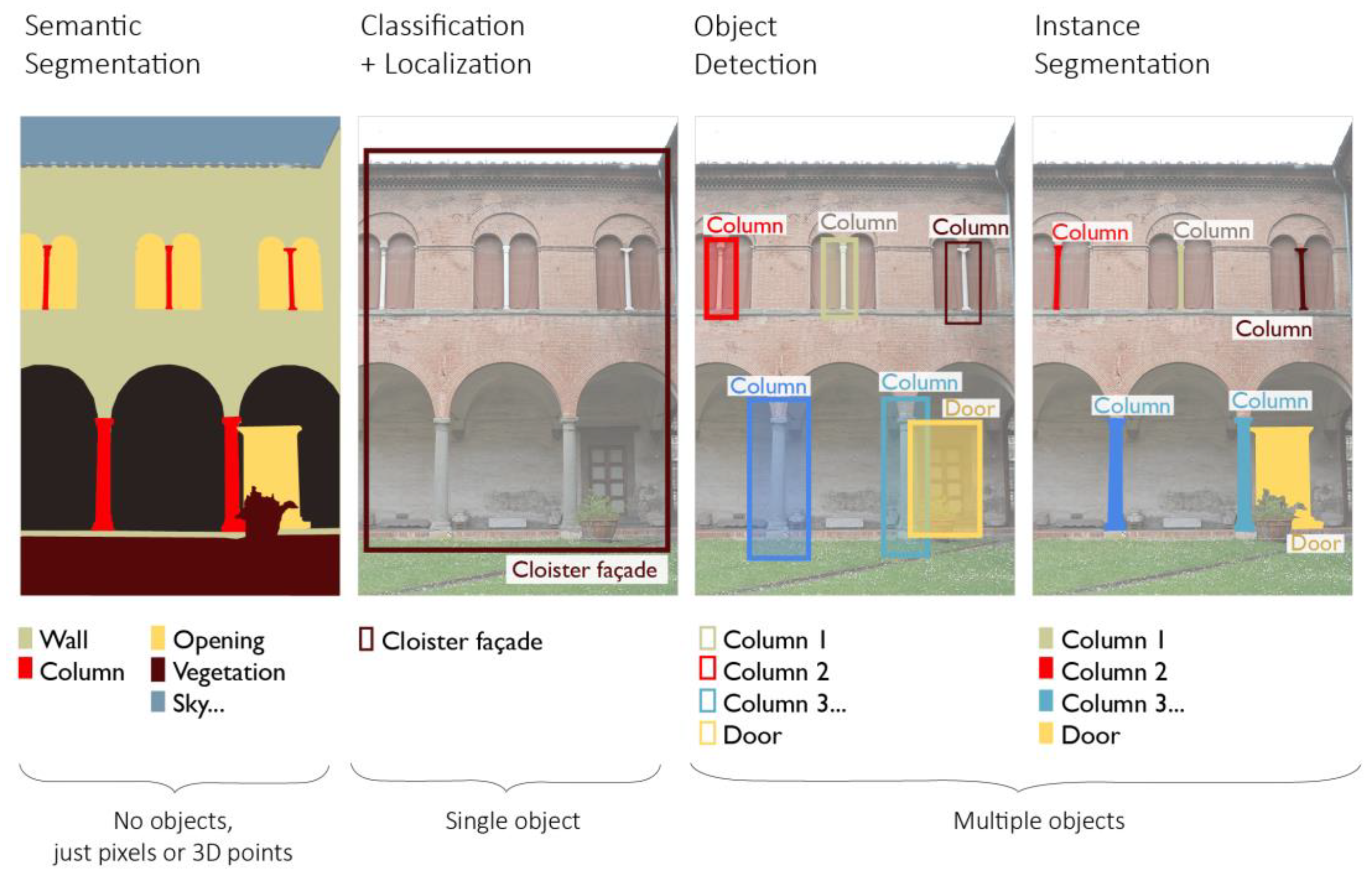

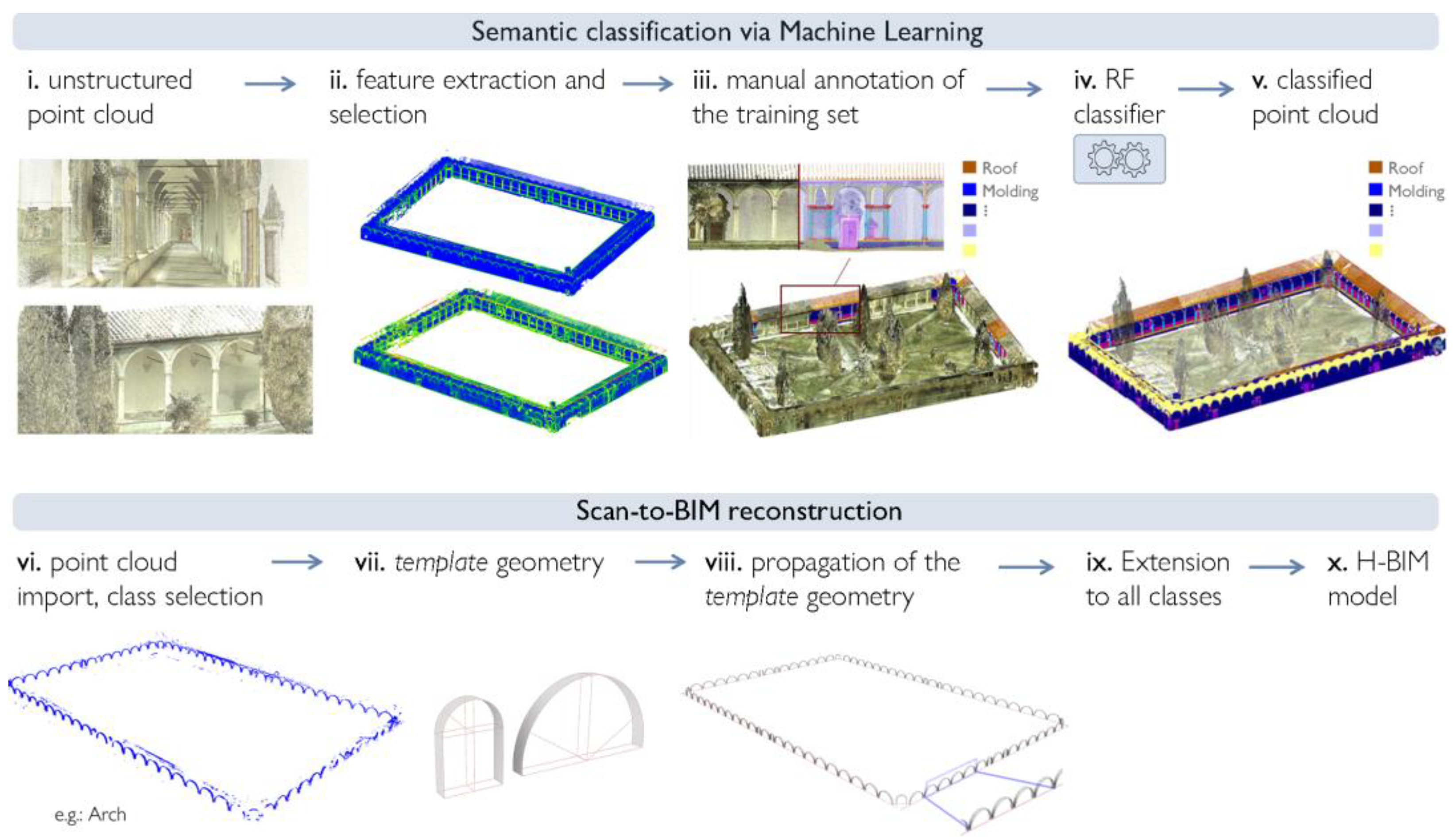

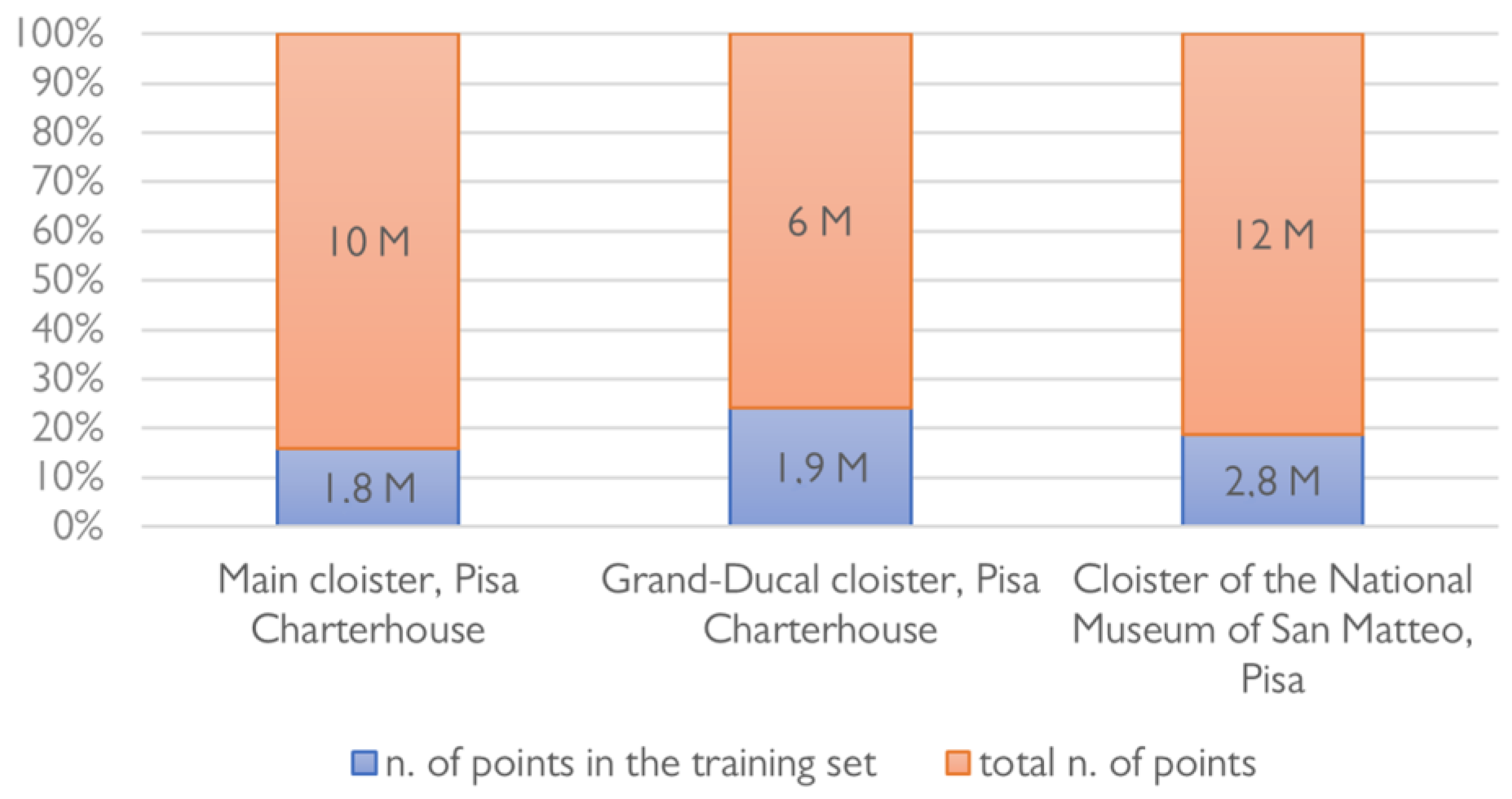

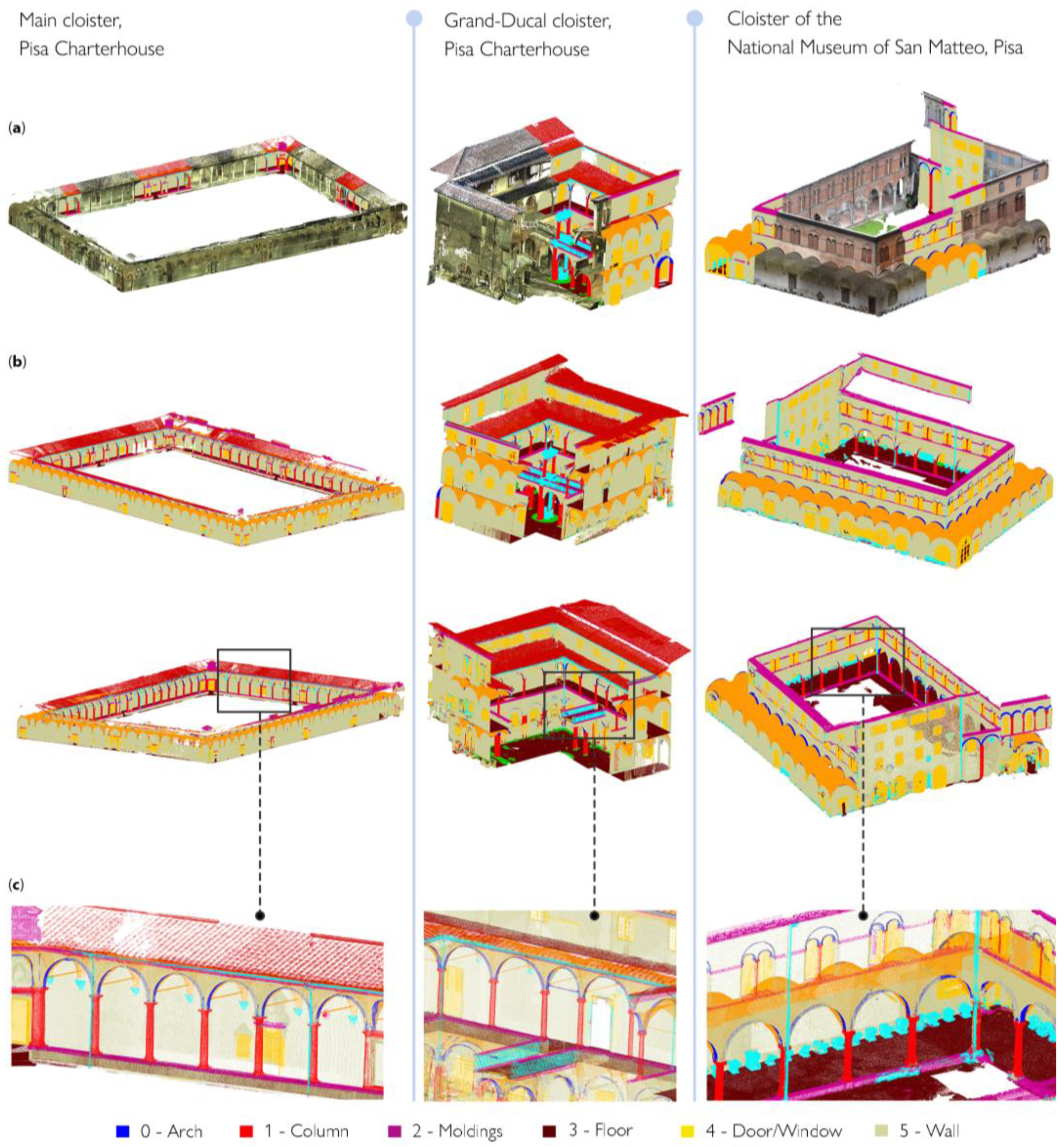
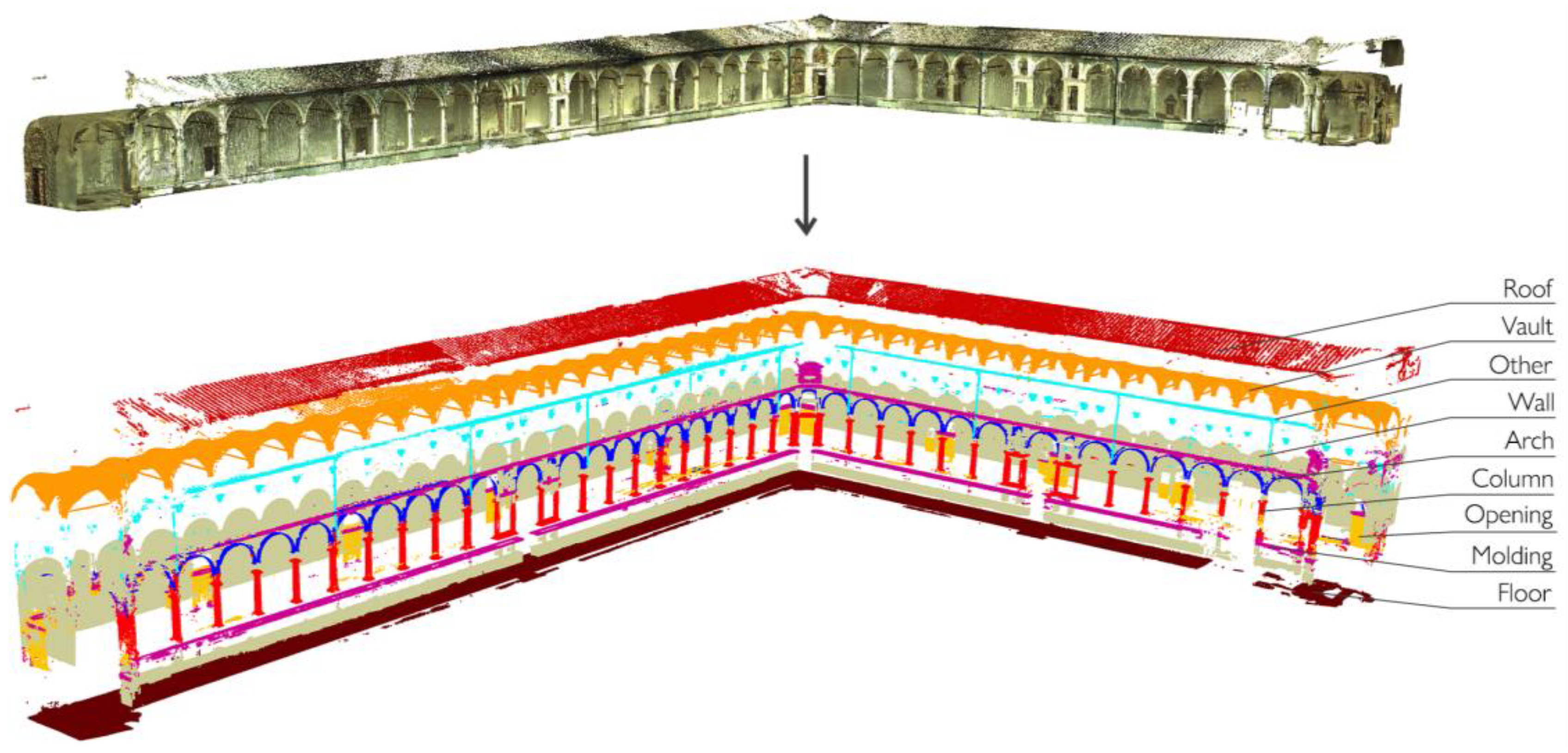
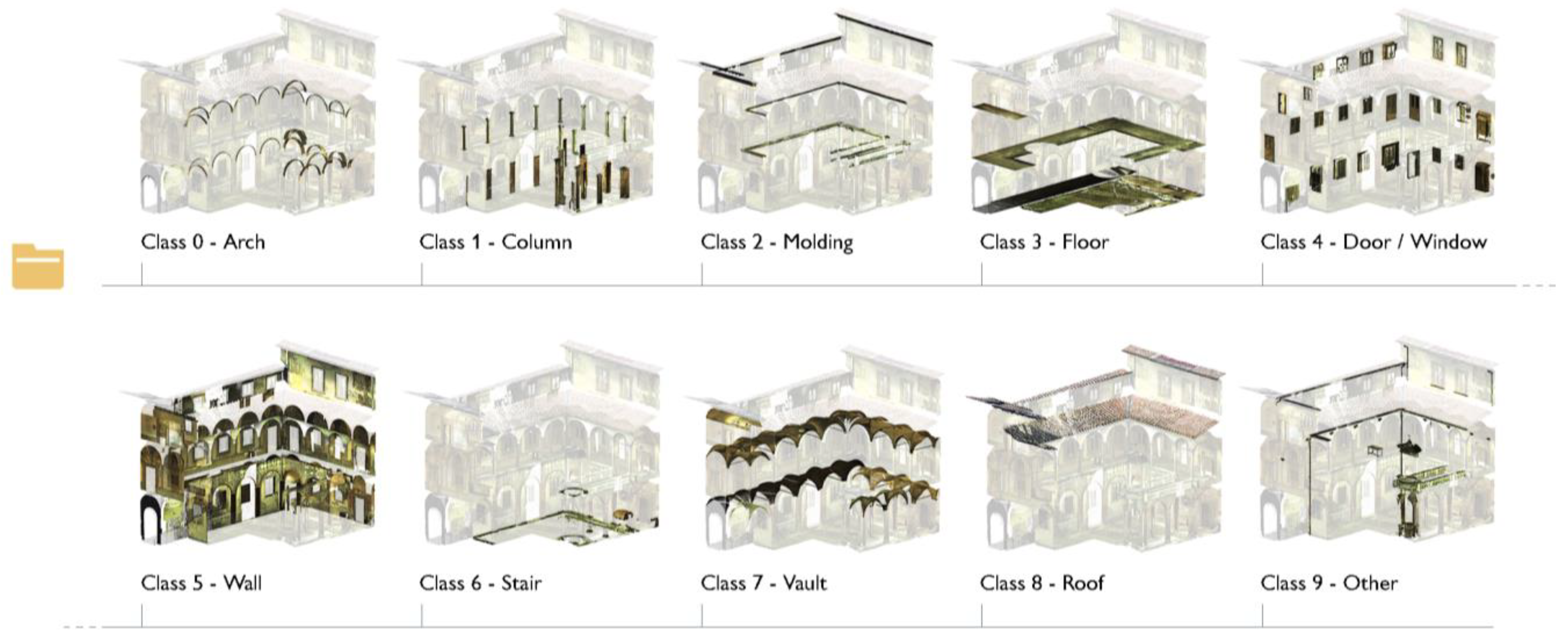


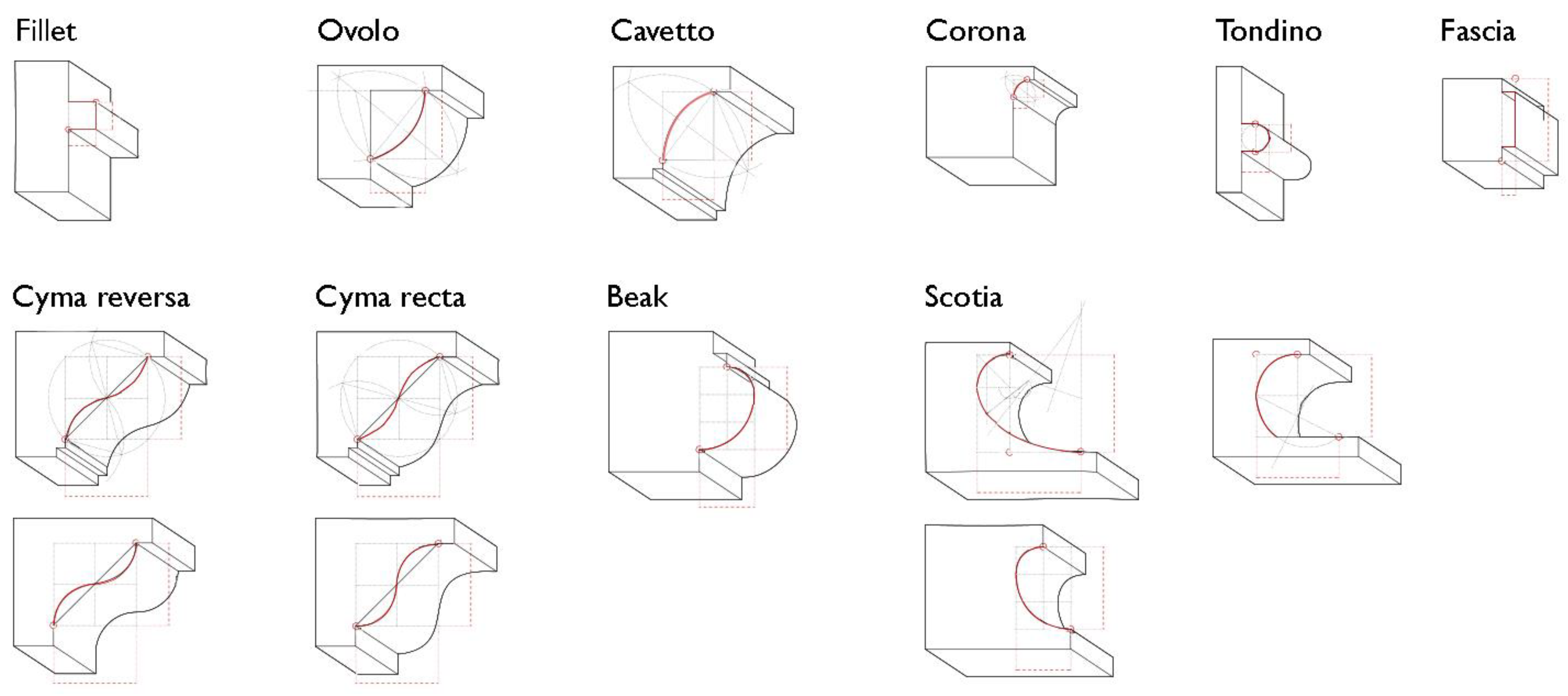
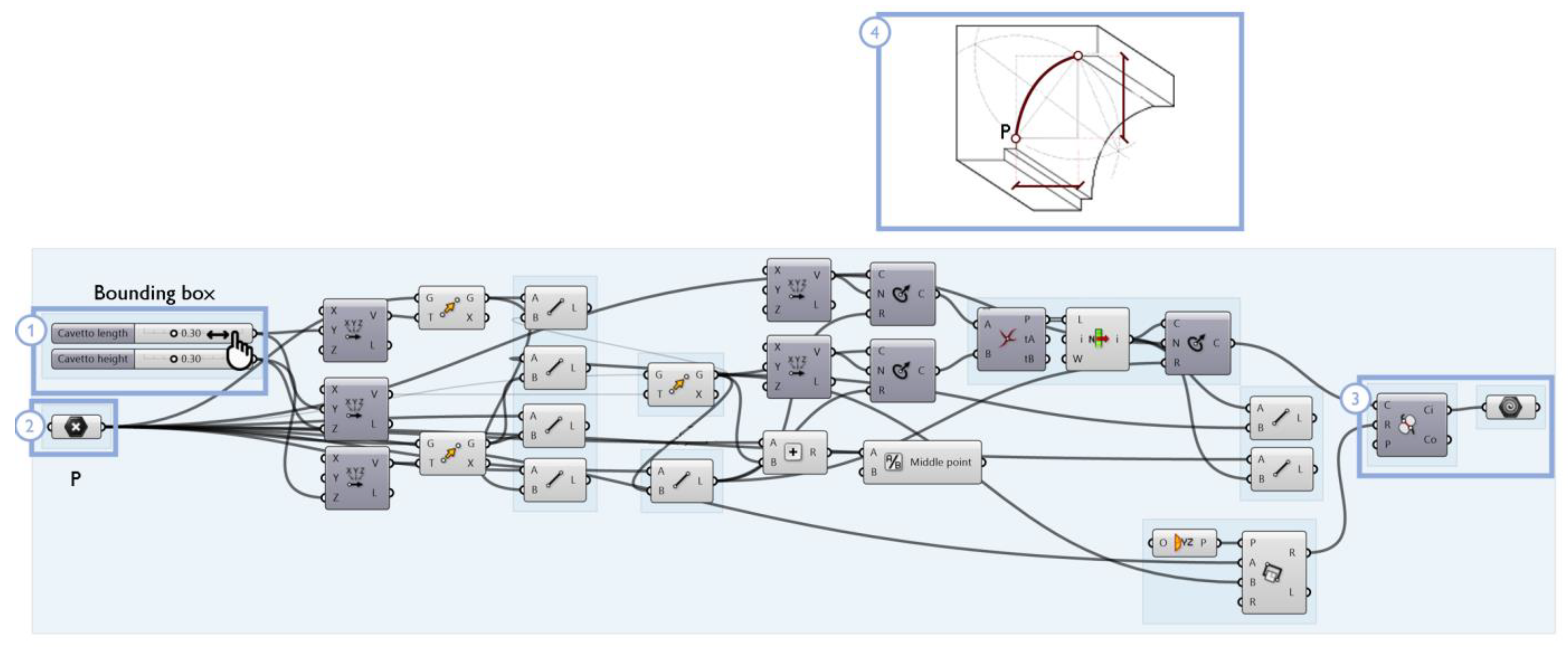
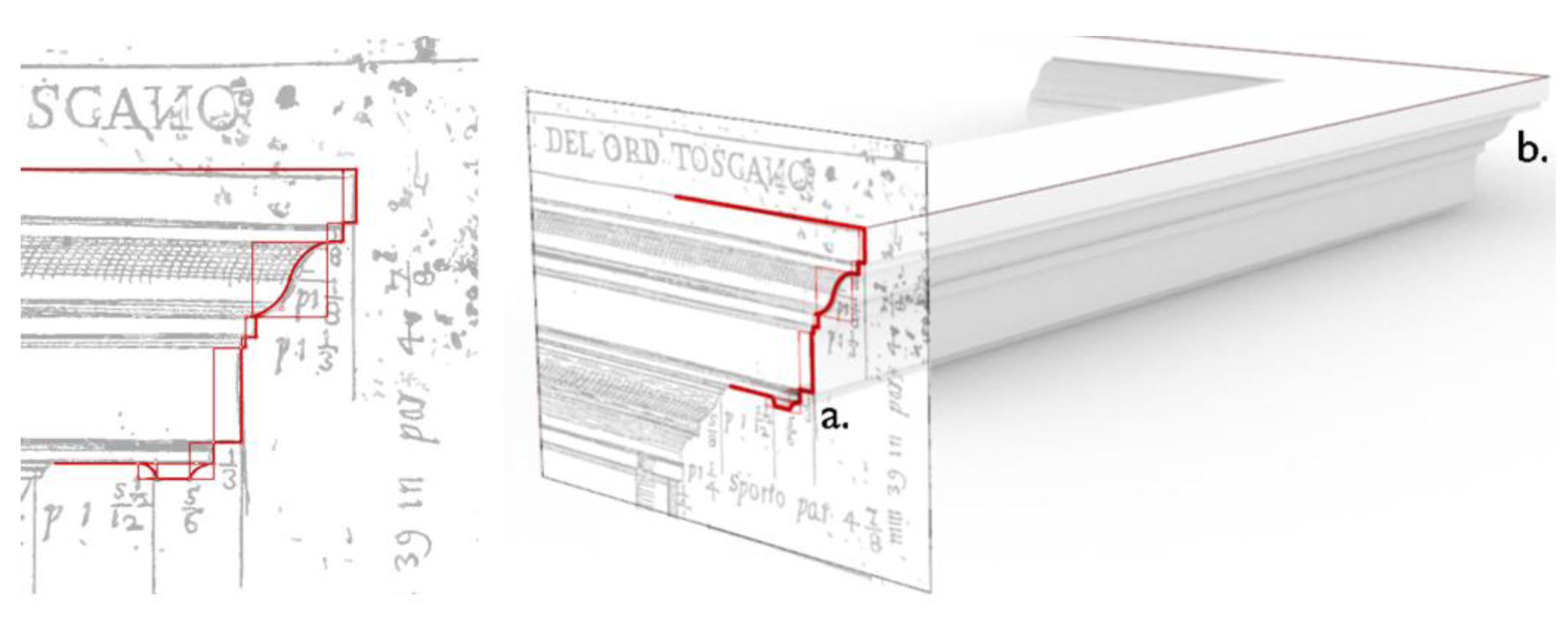
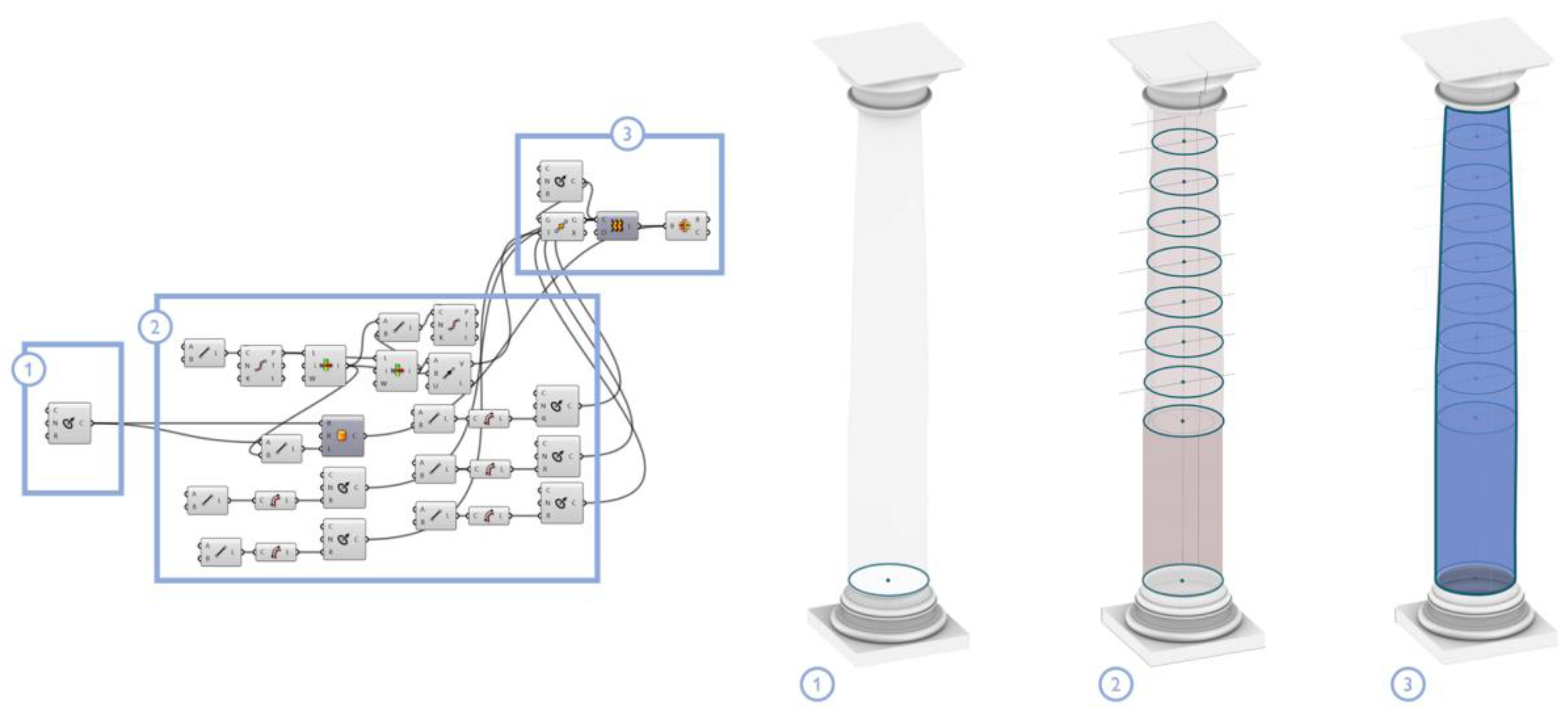

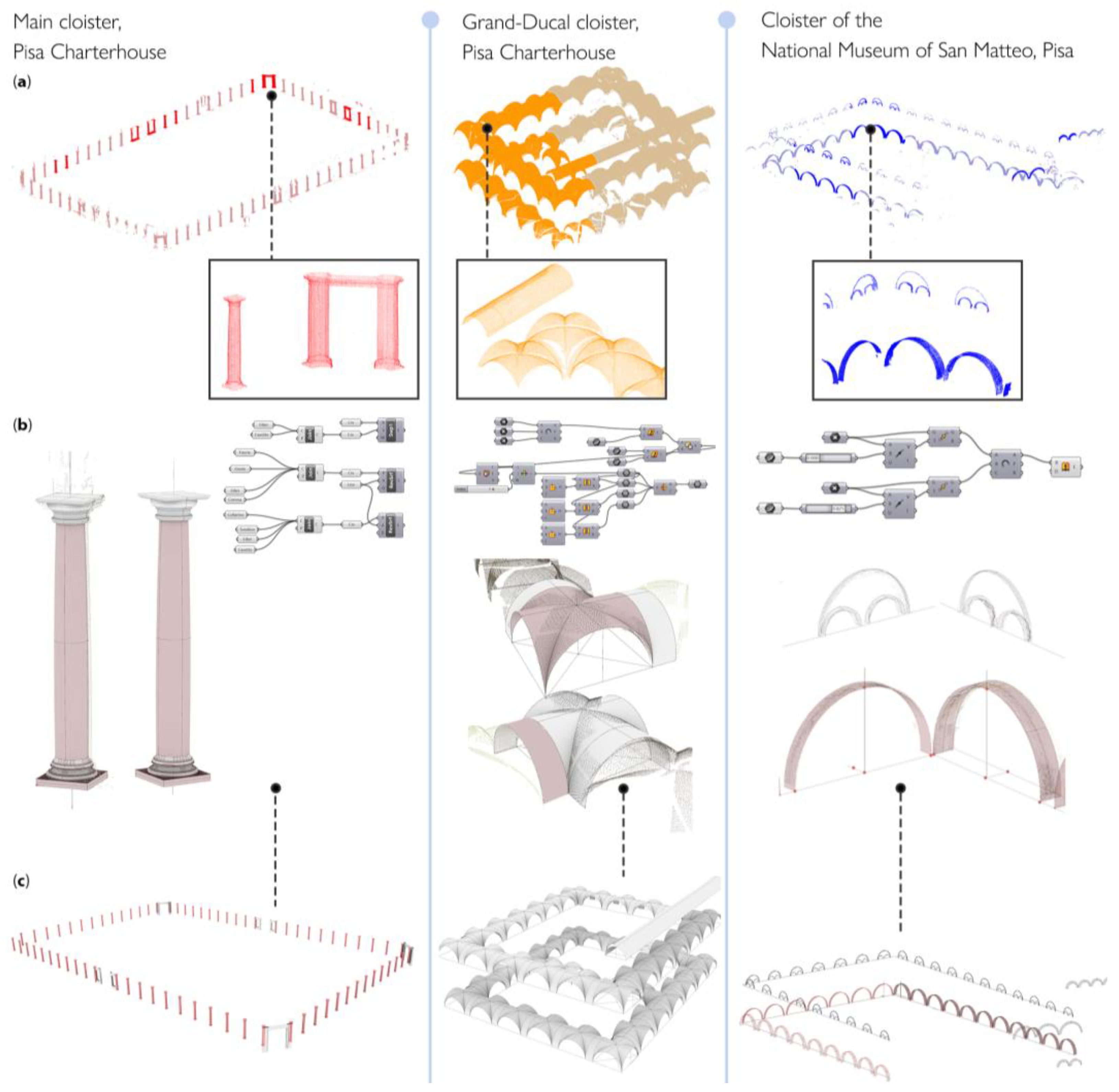

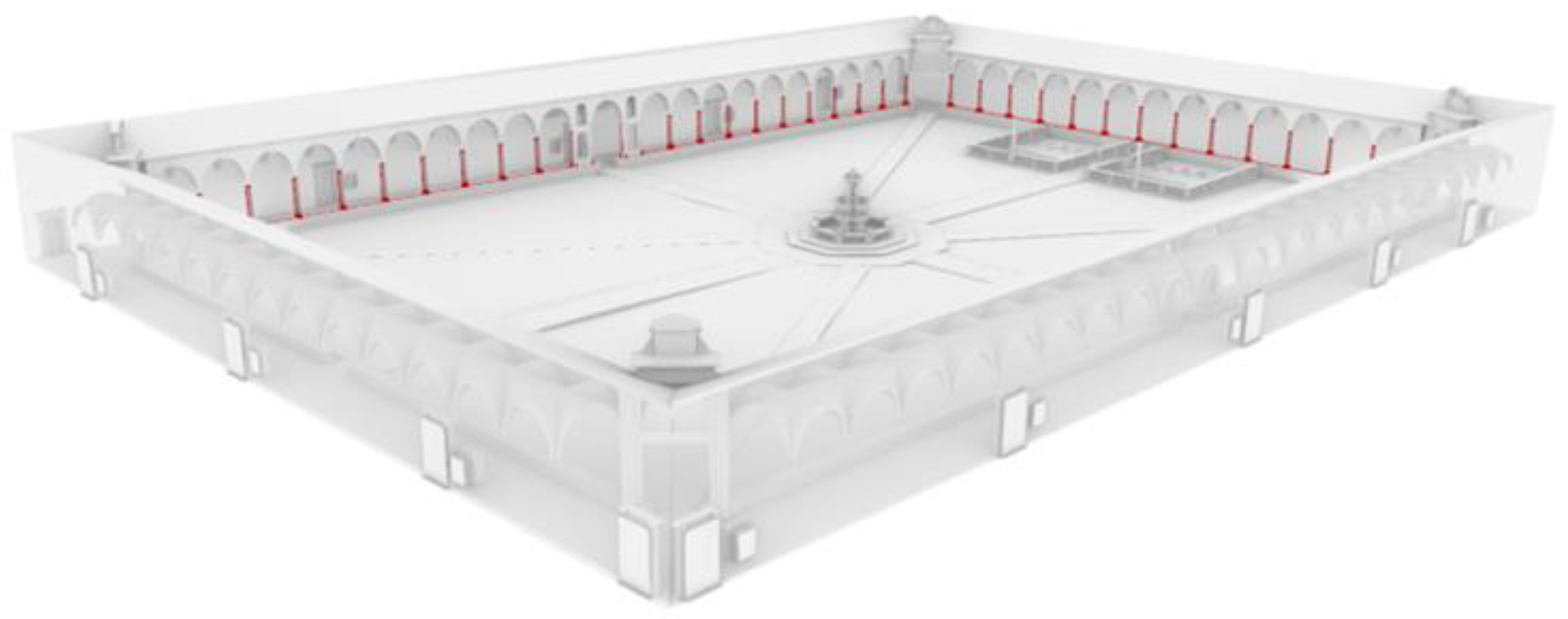


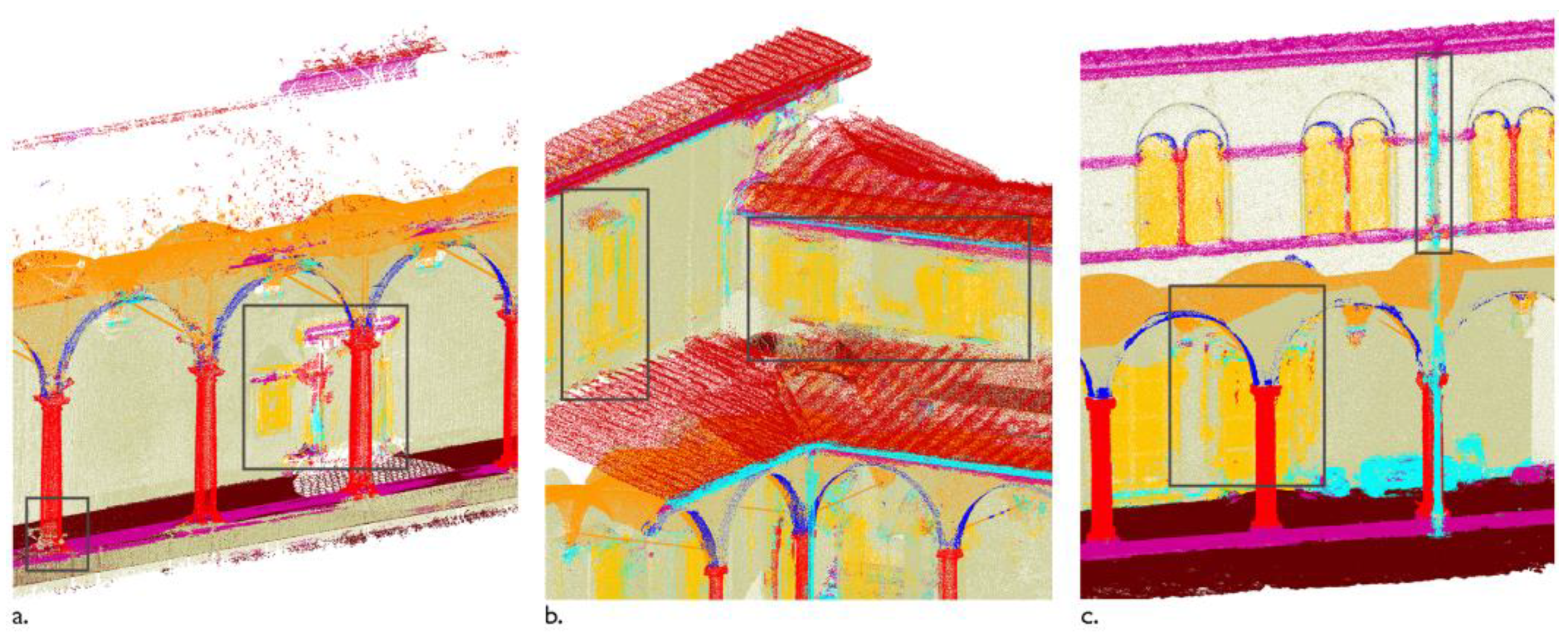
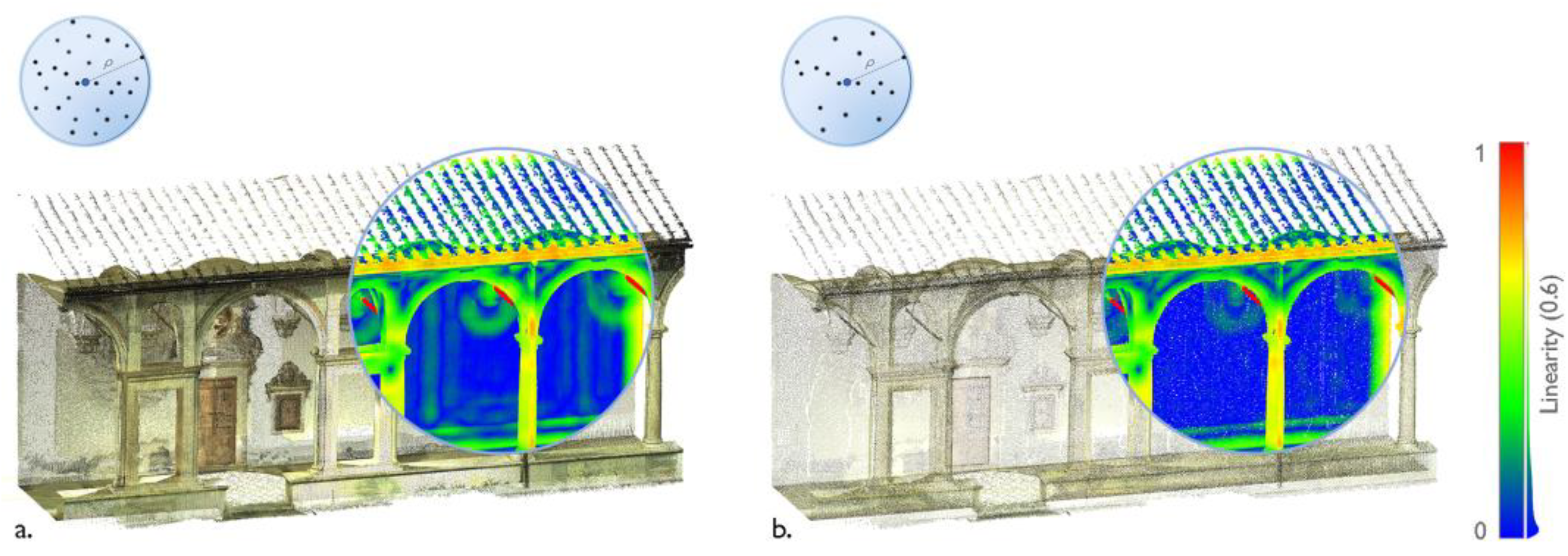

| Grand Cloister, Pisa Charterhouse | Grand-Ducal Cloister, Pisa Charterhouse | Cloister Museum of San Matteo, Pisa | |
|---|---|---|---|
| n. of classes | 9 | 10 | 9 |
| Avg. classes | 93.49% | 83.03% | 84.37% |
| Avg. precision | 95.56% | 82.07% | 89.71% |
| Avg. accuracy | 99.30% | 98.04% | 98.73% |
| Avg. F1-score | 94.44% | 81.53% | 85.98% |
Disclaimer/Publisher’s Note: The statements, opinions and data contained in all publications are solely those of the individual author(s) and contributor(s) and not of MDPI and/or the editor(s). MDPI and/or the editor(s) disclaim responsibility for any injury to people or property resulting from any ideas, methods, instructions or products referred to in the content. |
© 2023 by the authors. Licensee MDPI, Basel, Switzerland. This article is an open access article distributed under the terms and conditions of the Creative Commons Attribution (CC BY) license (https://creativecommons.org/licenses/by/4.0/).
Share and Cite
Croce, V.; Caroti, G.; Piemonte, A.; De Luca, L.; Véron, P. H-BIM and Artificial Intelligence: Classification of Architectural Heritage for Semi-Automatic Scan-to-BIM Reconstruction. Sensors 2023, 23, 2497. https://doi.org/10.3390/s23052497
Croce V, Caroti G, Piemonte A, De Luca L, Véron P. H-BIM and Artificial Intelligence: Classification of Architectural Heritage for Semi-Automatic Scan-to-BIM Reconstruction. Sensors. 2023; 23(5):2497. https://doi.org/10.3390/s23052497
Chicago/Turabian StyleCroce, Valeria, Gabriella Caroti, Andrea Piemonte, Livio De Luca, and Philippe Véron. 2023. "H-BIM and Artificial Intelligence: Classification of Architectural Heritage for Semi-Automatic Scan-to-BIM Reconstruction" Sensors 23, no. 5: 2497. https://doi.org/10.3390/s23052497
APA StyleCroce, V., Caroti, G., Piemonte, A., De Luca, L., & Véron, P. (2023). H-BIM and Artificial Intelligence: Classification of Architectural Heritage for Semi-Automatic Scan-to-BIM Reconstruction. Sensors, 23(5), 2497. https://doi.org/10.3390/s23052497










